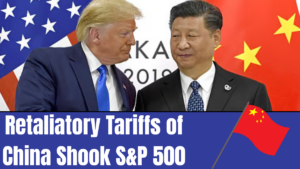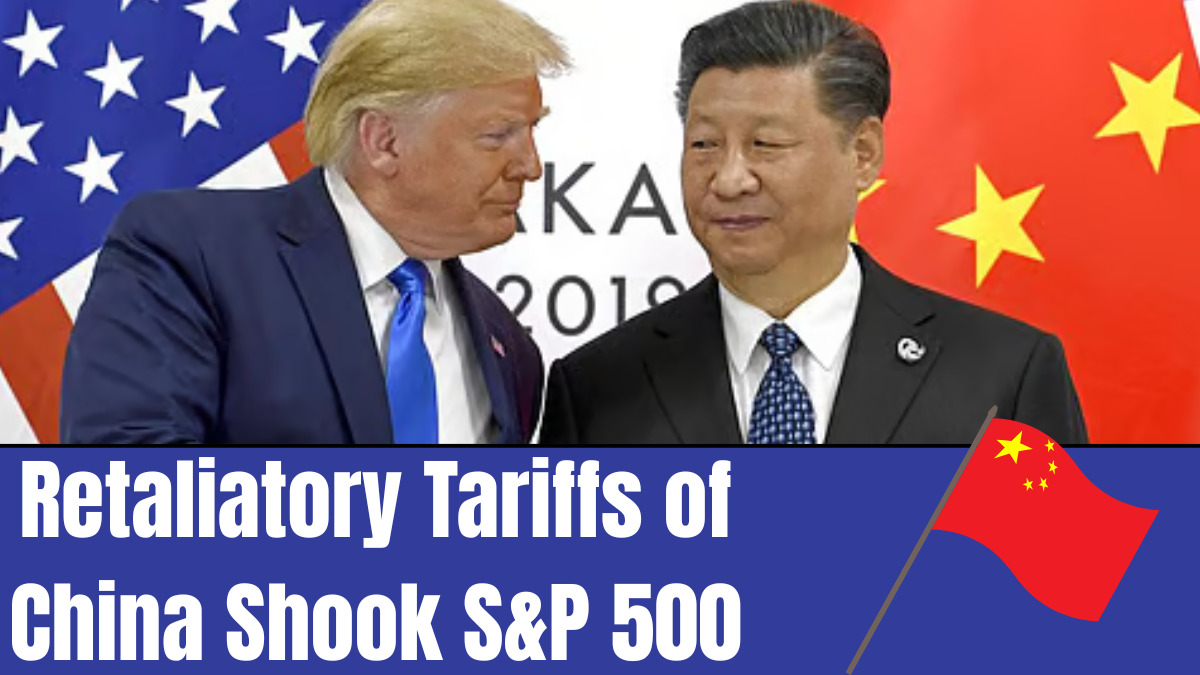The US stock market has recently witnessed a dramatic shift after China imposed a 34% retaliatory tariff on American goods. This move has deepened fears of a prolonged trade war, triggering panic across global financial markets. With the S&P 500 slipping into correction territory, investors are left wondering what lies ahead.
A few months back, the S&P 500 was charting record highs. But following the announcement of tariffs by China in response to US President Donald Trump’s sweeping trade policies, the index has declined over 10% from its peak. This development fits the definition of a “market correction,” a common yet unsettling phase in financial markets.

What Are Market Corrections?
Market corrections occur when a stock index like the S&P 500 or Dow Jones drops by more than 10% from its recent peak. While the term may sound alarming, corrections are part of the natural ebb and flow of markets. They often serve as a reality check, bringing overvalued stocks back to more reasonable levels.
These corrections are not always a sign of deeper economic trouble. In fact, a correction may simply reflect short-term investor sentiment rather than long-term fundamentals. However, they can also serve as a precursor to bear markets, particularly if economic conditions deteriorate further.
Why Do Market Corrections Happen?
Corrections are driven by a variety of factors. These can include rising inflation, high stock valuations, geopolitical uncertainty, or sudden policy changes. In the current scenario, several elements are converging:
- Tariff tensions: President Trump’s aggressive trade policies have created global uncertainty.
- Inflation concerns: US inflation has exceeded the Federal Reserve’s 2% target.
- Investor caution: With markets overheated earlier this year, even a slight shock was enough to trigger selloffs.
Market Corrections vs Bear Markets
A correction becomes a bear market when the decline exceeds 20%. While bear markets tend to last longer and have a more severe impact on portfolios, most corrections are short-lived. According to Deutsche Bank, out of 60 market corrections since 1928, only 17 evolved into bear markets.
Historical Trends of Corrections
Deutsche Bank research shows that nearly 44% of historical corrections occurred in or around a recession. The remaining 56% had no direct link to economic downturns. Most corrections ended with markets stabilizing between 10% and 20% below their highs.
The current decline, therefore, might not necessarily indicate a long-term crisis—but vigilance is crucial.
Will the Market Dip Further?
Three key factors could influence the trajectory of the market:
- The Trump Factor: With Trump back in office, his unpredictable policies continue to rattle markets. Analysts worry about prolonged instability if trade tensions escalate.
- Inflation and Interest Rates: Inflation has hit 2.8%, and if it remains elevated, the Federal Reserve may hold off on rate cuts. This would tighten liquidity and impact corporate earnings.
- Government Spending: A rising budget deficit—projected at $1.9 trillion—is another red flag. The Congressional Budget Office warns that excessive government borrowing may lead to higher interest rates.
Global Reactions and Economic Impact
China’s new AI tool, DeepSeek, is also being blamed for contributing to market jitters. Meanwhile, Canada has reported its first job losses since 2022, and Japan is witnessing a severe downturn in its banking sector.
The European Union remains split on how to respond. While France is calling for investment freezes in the US, other member states remain cautious about retaliatory measures.
Despite encouraging US job data, the long-term outlook remains uncertain. The coming months will test the resilience of global economies as the ripple effects of these policies unfold.
Frequently Asked Questions (FAQs)
What is a market correction?
A market correction occurs when a stock index falls more than 10% from its most recent peak. It is usually short-term and does not always lead to a bear market.
How is a correction different from a bear market?
While a correction involves a drop of over 10%, a bear market is marked by a decline of 20% or more. Corrections are typically brief, while bear markets last longer and are more severe.
What triggered the current correction?
The 34% retaliatory tariff imposed by China on US goods and broader concerns over inflation, interest rates, and government spending have contributed to the latest correction.
How often do corrections happen?
According to Deutsche Bank, the US stock market has experienced 60 corrections since 1928. Only 17 of those led to bear markets.
Can corrections be predicted?
No, corrections are difficult to predict. They can be triggered by various economic, political, or emotional factors and often come with little warning.
What should investors do during a correction?
Financial experts advise staying calm, reviewing long-term investment strategies, and avoiding panic selling. Corrections can also offer buying opportunities for well-researched stocks.
Click here to know more.
Aanchal is a passionate writer with a keen interest in storytelling, content creation, and creative expression. She enjoys exploring diverse topics and crafting engaging narratives that captivate readers.

